- News
- Reviews
- Bikes
- Accessories
- Accessories - misc
- Computer mounts
- Bags
- Bar ends
- Bike bags & cases
- Bottle cages
- Bottles
- Cameras
- Car racks
- Child seats
- Computers
- Glasses
- GPS units
- Helmets
- Lights - front
- Lights - rear
- Lights - sets
- Locks
- Mirrors
- Mudguards
- Racks
- Pumps & CO2 inflators
- Puncture kits
- Reflectives
- Smart watches
- Stands and racks
- Trailers
- Clothing
- Components
- Bar tape & grips
- Bottom brackets
- Brake & gear cables
- Brake & STI levers
- Brake pads & spares
- Brakes
- Cassettes & freewheels
- Chains
- Chainsets & chainrings
- Derailleurs - front
- Derailleurs - rear
- Forks
- Gear levers & shifters
- Groupsets
- Handlebars & extensions
- Headsets
- Hubs
- Inner tubes
- Pedals
- Quick releases & skewers
- Saddles
- Seatposts
- Stems
- Wheels
- Tyres
- Health, fitness and nutrition
- Tools and workshop
- Miscellaneous
- Buyers Guides
- Features
- Forum
- Recommends
- Podcast
feature
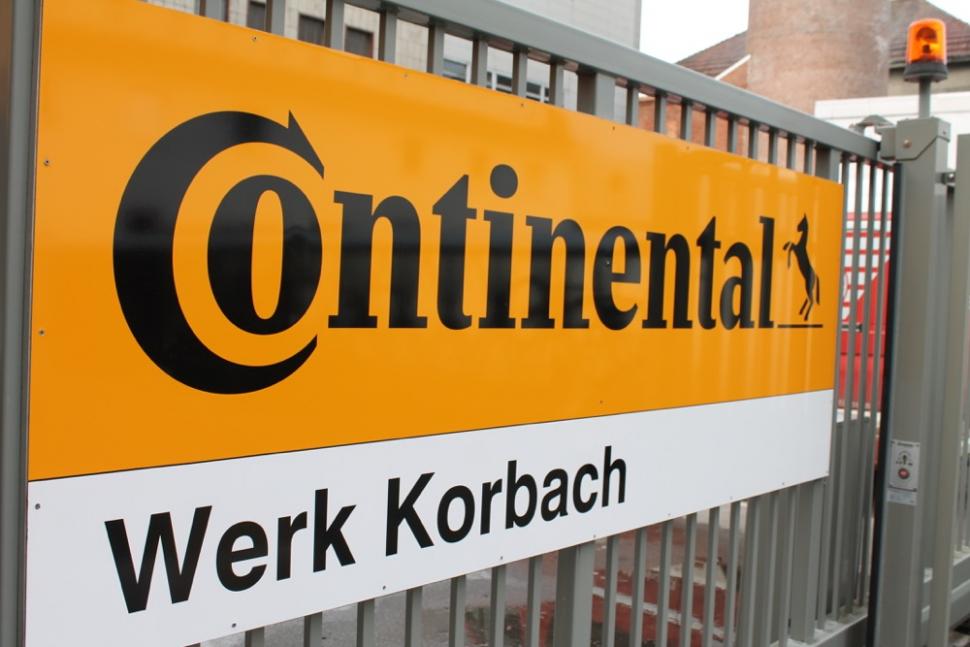 Conti sign 1
Conti sign 1Tech Travel: Inside Continental
Last month we visited the Continental Bicycle Tyres Division in Korbach, Germany for an insight into the brand and to see how they make tyres. Here’s what we found out.
Why I'm here
Most often when we visit brands on their home turf it’s for the launch of a specific product or an updated range, but that wasn’t the case here. We were in Germany simply to find out more about Continental, check out the production facilities and talk to the staff about why they do things the way they do. They weren’t giving us the hard sell, they were just showing us how they work.
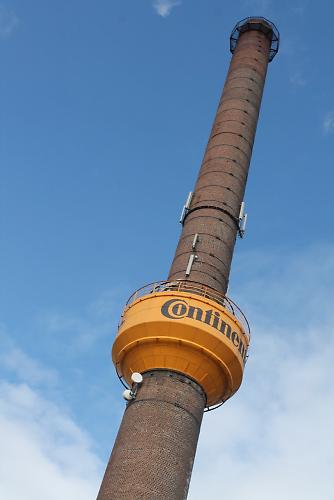
We were actually piggybacking a trip for bike dealers organised by Conti’s UK distributor Cambrian Tyres.
What I learnt
I’ll give you a few facts to kick off:
• Although they make tubeless tyres (no inner tube, just a tyre on an airtight rim) for mountain biking, Continental don’t do tubeless road tyres. According to Head of Marketing/Sales Jorg Malcherek, that technology 'sucks'. His word, not mine. That said, one of the other Continental guys told us that they could be interested in doing tubeless tyres for gravel bikes where the ability to run lower air pressures without the danger of pinch flats has an attraction. Don’t hold your breath for that, though. If it does happen, it’s a way off.

• All BlackChili is not the same. BlackChili is the name Continental gives to its high-performance tread compound used on both top-level road and mountain bike tyres. BlackChili is a mix of natural rubber and synthetic rubber with the addition of ‘nanometric carbon soot particles’. However, the BlackChili compound is actually a range of different compounds; the exact recipe varying according to the intended use. That’s probably not too much of a surprise if you think about it. Usually, there’s a trade-off between rolling resistance, grip and durability but Conti reckon that BlackChili adds improvements in all areas (naturally!).

• Conti’s Pure Grip compound is a newer addition to the range, developed at Korbach and made in Hefei, China. Conti rank it below BlackChili in terms of performance. It’s not as fast as their BlackChili compounds but it is more durable.
• Not many brands still produce bike tyres in Europe, but although they have Asian production, Continental want to continue making tyres here in Germany. Conti is, after all, a German company. It sees itself as a premium tyre brand and has a focus on maintaining that reputation. All of the BlackChili tyres are made here.
• Aftermarket tyre sales account for 70% of Conti’s bike tyre production, the remaining 30% of tyres being specced on bikes as original equipment.
• Conti say that a 20mm tyre with 160psi, a 23mm tyre at 123psi, a 25mm tyre at 94psi and a 28mm tyre at 80psi all have the same rolling resistance. The wider tyres provide more comfort, of course.
• Before a new tyre comes to market, Conti put it on a machine with a 65kg mass pressing down on it, and roll it at 50kph. A road tyre needs to be capable of 7,000km, a mountain bike tyre about half that.
What I saw
Some of the Korbach plant has been here for over a century while some of it is much more modern. As well as bicycle tyres, they produce 15 million winter car tyres here every year along with motorcycle tyres and various other products. The plant employs 3,500 workers. Conti have 190,000 employees worldwide at 291 locations in 46 different countries.
It won’t surprise you to learn that large parts of this place have a light coating of black dust and other parts have a thick coating of black dust. They don’t even bother painting some areas because that would be a waste of time. Of course, there’s a distinctive smell of rubber everywhere.

There are essentially five parts to a clincher. These are they:
• Casing – The supple body of the tyre, made of nylon (usually) in various numbers of threads per inch (TPI), that’s covered in rubber. Different tyres have different numbers of casing layers (called the ply). A higher TPI makes a finer material that results in a smoother tyre with more puncture protection. A coarser material makes a more cut resistant and robust tyre.
• Bead – The bit around the edge that secures the tyre to the wheel rim. These are made from wire or foldable Kevlar.
• Anti-chafing strip – The reinforcement that protects the bead. It’s nylon on Conti’s road tyres, a solid rubber strip on their mountain bike tyres.
• Tread – The compound that comes into contact with the ground. Conti say that the tread pattern doesn’t make much difference on the road. It has a role in certain circumstances, but it doesn’t do much, unlike off-road when the tread pattern is vital in determining grip on conformable ground.
• Protection layer – Manufacturers sometimes put an extra-thick rubber compound below the tread, often in a different colour, to provide some resistance against punctures. Conti’s Plus Breaker is essentially thick rubber but they use a tightly woven polyester PolyX Breaker in higher end tyres, and Vectran, a lightweight liquid-crystalline polymer, in the top-end models. Vectran is similar to Kevlar but it is more waterproof. Conti use a double layer in their 4-Season tyres. Stat fans will be pleased to hear that Vectran is five times as strong as steel.
One other feature that you’ll see on the sidewalls of some Conti tyres is the distinctive brown, grid-like DuraSkin layer. It’s a polyamide fabric that’s designed to protect the sidewalls in tough conditions, such as riding over the cobbles in Paris-Roubaix.
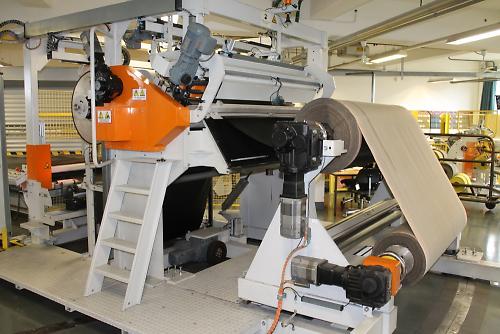
Making tyres is a more intricate process than you might imagine, with several different stages. It’s not just a case of bunging a load of rubber in a mould, you know.
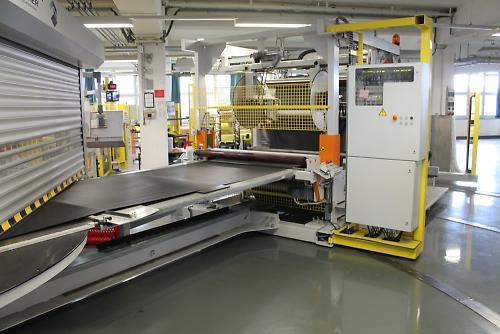
Conti make their own casing material: sheets of nylon threads that are covered in rubber. First, these sheets are sliced into the slices that will go on to be made into individual tyres.

This machine is making the bead. The wire comes in on big spools and comes out as a fully formed bead.

This thick, heavy black stuff is the raw material that goes on to become the tread. It gets forced through a die that shapes it, and it eventually comes out to the size, shape and thickness required.

The next stage is to put a length of the casing onto a drum where it is tensioned, then the breaker and the tread are added, and the cover that stops the material sticking to itself when wound up is removed.

Next the bead is put on and the chafers are added automatically.

Then the labels are added and the joint where the two ends of the tyre have been joined together are pressed and smoothed.
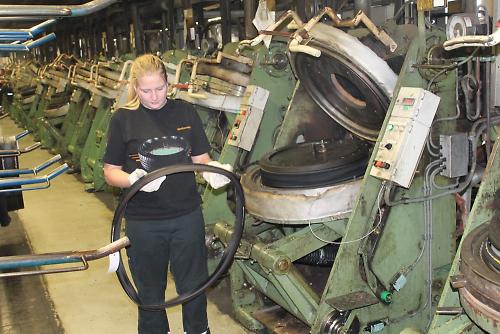
Only then does each tyre go into an individual mould where it is cured. This vulcanisation process makes it much more durable than would otherwise be the case. The tyre sits between a 160°C mould and a bladder with steam pushing it into place. It stays there for between 3mins and 4:30mins, depending on the tyre.

Making tubulars is a similar process to begin with although each one has to be stitched individually on a machine. A standard butyl inner tube goes inside and then a base cloth, the rim tape, is added that will eventually be stuck down onto the wheel’s rim.
For more info on Conti go to www.conti-online.com or www.conti-tyres.co.uk/conticycle.
Mat has been in cycling media since 1996, on titles including BikeRadar, Total Bike, Total Mountain Bike, What Mountain Bike and Mountain Biking UK, and he has been editor of 220 Triathlon and Cycling Plus. Mat has been road.cc technical editor for over a decade, testing bikes, fettling the latest kit, and trying out the most up-to-the-minute clothing. He has won his category in Ironman UK 70.3 and finished on the podium in both marathons he has run. Mat is a Cambridge graduate who did a post-grad in magazine journalism, and he is a winner of the Cycling Media Award for Specialist Online Writer. Now over 50, he's riding road and gravel bikes most days for fun and fitness rather than training for competitions.
Latest Comments
- Griff500 10 min 53 sec ago
Are you saying the figures in the article are wrong (DA 2507g; Red 2496g) or are you arithmetically challenged?
- andystow 12 min 23 sec ago
There's a good Youtube channel of a London-based cyclist who uses one, and I think sells them. It's been over a year since any new videos, though.
- hawkinspeter 17 min 41 sec ago
Yeah - I was meaning blocked by the green-light flow of traffic.
- hawkinspeter 19 min 27 sec ago
Unfortunately, Shimano don't make it easy to work with their Di2 wire protocols....
- andystow 20 min 27 sec ago
I've never found a bus system that didn't have a learning curve. I've ridden buses in at least:...
- chrisonabike 47 min 7 sec ago
Agreed - I was just going on ones which IIRC were mentioned incidentally as supporters e.g. I think I read RNIB (who certainly were against these...
- chrisonabike 52 min 20 sec ago
Again hope I'm not coming across as picking a fight! I think two "citation needed" there though....
- KDee 56 min 46 sec ago
Also the same as NS here in the Netherlands. No full size bikes during peak hours, only folders (and they're supposed to meet a minimum dimension...
- jaymack 1 hour 57 min ago
Did you pay on a credit card? If you did you may be able to take advantage of s. 75 refund
- The_Ewan 2 hours 15 min ago
I think it's reasonable to say that everyone on the UK roads has extensive experience with traffic doing circa 30mph.
Add new comment
15 comments
They use butyl in their tubs? Not latex?
Did he elaborate on that?
There's me thinking that my 25mm GP 4000's that were showing thread though the tires in a couple of place, (looking for excuses for the lack of quality control) I thought they were made in China.
Being brand new I had them replaced, but perhaps they were made on a Friday afternoon in Germany instead.
My 25mm 4 Seasons seemed to have a special compound that punctured easily. Some Vredestein Fortezza Senso Xtreme faired better for winter duty.
There's me thinking that my 25mm GP 4000's that were showing thread though the tires in a couple of place, (looking for excuses for the lack of quality control) I thought they were made in China.
Being brand new I had them replaced, but perhaps they were made on a Friday afternoon in Germany instead.
My 25mm 4 Seasons seemed to have a special compound that punctured easily. Some Vredestein Fortezza Senso Xtreme faired better for winter duty.
Personally, I like the slightly fatter tyre because I'm a slightly fatter rider.
The final factor to take into account is the flexibility / pliability etc of the casing, for which the TPI count can sometimes be a fairly good proxy. A highly pliant/conformable (ooh I love those words) casing can compensate for much/all/ or even more than compensate the size differences. A crappy 28mm casing might have worse rolling resistance than a very high quality 23. Based on equal quality of casing the big ones will be better rolling, but once you try to compare between models and manufacturers it becomes much more tricky. A central database of test results done in a standard way would be great! Like many things, comparing apples with bananas doesnt help much.
I would imagine the 22mm tyre would be a tub compared to the 23mm clincher.
"• Conti say that a 22mm tyre with 160psi, a 23mm tyre at 123psi, a 25mm tyre at 94psi and a 28mm tyre at 80psi all have the same rolling resistance. The wider tyres provide more comfort, of course."
Anyone still running 23 (or even 25) with a frame that can go bigger needs their head read.
It's all about the sciencey-facts stuff proving fatter is faster, innit?
bertopresschart.jpg
now add in air resistance.
The thinking is that (to an extent, probably somewhere between 25 and a 28) a fatter tyre and wider/blunter rim is more aero. Certainly in a crosswind.
http://www.competitivecyclist.com/learn/25-vs-23
See? It's all good.
Yep there's a definite trade-off at higher speeds - this page has some simple, but useful figures and illustrations
http://www.rouesartisanales.com/article-1503651.html
That said there's also the comfort and grip factors to take into account. It looks like for non-racing applications (and a non-trivial number of those) it probably makes sense to use at least 25mm on modern ERTO 622 rims, especially the wider ones.
Well. I did have some 25mm Conti 4000 GPs. What I didn't like is the slight disconnected feeling I have when running them on my Fulcrum Racing Zeros. With 23mm Conti's they feel much better. Go figure. No head reading necessary.
What the bloody hell are you on about?
"Conti say that a 22mm tyre with 160psi, a 23mm tyre at 123psi"
That is a heck of a pressure jump for 1mm!
There's a show called "How it's Made" in North America. One of the things they showed was Continental road tires. Can't seem to find it on internet (don't think anyone uploaded it), but it really showed just how labor involved one tire is, and why they cost so much. It's labor, not material, we pay for. Very impressive.
Yeah, it should read 20mm – the tyre at 160psi. That's my typing error.
Corrected now. Apologies for that.